Chemistry projects feel like magic, do they not? If you think about some of your favorite science projects, the ones you love to try with your kids or the ones that amazed YOU as a kid, more likely than not most of them involved chemistry.
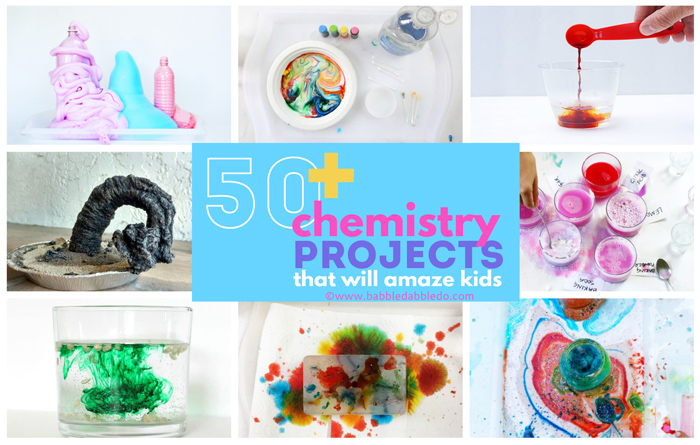 Now I know a lot of us associate chemistry with lab coats, beakers and specialty ingredients but the reality is there are so many chemistry projects you can do using very simple, easy to find ingredients, often found in your own pantry. And since these types of simple chemistry projects use relatively safe ingredients, they are perfect to try with younger kids, ie. preschool and elementary aged children! In fact I think it’s so important for young kids to have a positive association with chemistry from a young age that fosters a love of this branch of science.
Now I know a lot of us associate chemistry with lab coats, beakers and specialty ingredients but the reality is there are so many chemistry projects you can do using very simple, easy to find ingredients, often found in your own pantry. And since these types of simple chemistry projects use relatively safe ingredients, they are perfect to try with younger kids, ie. preschool and elementary aged children! In fact I think it’s so important for young kids to have a positive association with chemistry from a young age that fosters a love of this branch of science.
When most children are finally exposed to chemistry in school, it is at the high school level where the subject turns complex quickly; hopefully giving kids a chance to have fun at young age mixing up concoctions and watching chemical reactions will help carry their interest through the more complicated days of study ahead.
This post is a GIANT compilation of chemistry projects that would be great for the science fair, classroom demos, or at home science with your kids.
Before we get started let’s talk a little bit about what chemistry is and for parents I also included a section covering How to Do Chemistry Projects at Home. If you are a classroom teacher you can skip this section and head right to the projects here.
What is chemistry?
Chemistry is the branch of science that studies matter (anything that has mass and takes up space) and its properties, and how different substances (especially molecules and their atoms) interact, combine, and change to form new substances.
Here are some important definitions to know when working on chemistry projects:
- Element A substance that cannot be separated into any further substances. There are 120 known elements.
- Atom The smallest particle of an element
- Molecule Groups of atoms held together by a chemical bond.
- Ion An atom or molecule that has an electric charge
While most people think of chemistry purely in terms of chemical reactions, chemistry also covers the study of the states of matter as well as the density of substances.
The five branches of chemistry are:
- Analytical chemistry
- Physical chemistry
- Organic chemistry
- Inorganic chemistry
- Biochemistry
Read more about what each branch covers here.
How to Do Chemistry Projects at Home
Many chemistry projects can be done at home using simple materials and are a great way to foster a love of science in kids! I wholeheartedly believe that a wow factor in a project engages and inspires kids to learn more. If you want to try chemistry projects at home here are some suggestions and precautions:
Safety First
Even though most of the projects in this list use safe, easy to find materials they should be used with safety precautions and under adult supervision. Why? Sometimes the chemical reaction that ensues can irritate the skin or eye, can be harmful if swallowed, or is just plain sticky or messy and adults should be on hand to supervise use. Also be advised that there are a few projects on this list that do use materials that are unsafe for kids to handle. These projects are meant to be demonstrations only and are labeled accordingly.
Supplies
- Use household items for chemistry The classic chemistry project that never fails to impress is the reaction of baking soda (sodium bicarbonate) and vinegar (look for a number of variations on this classic in our Acids and Bases section) but there are lots of other great ingredients for chemistry to find in your kitchen including sugar, salt, yeast, lemons, dish soap, milk, Kool- Aid, cabbage, gelatin, and food coloring to name a few…before you order any materials online, try some projects with pantry essentials.
- Worth the investment If you find yourself with some young chemists on hand you may want to invest in a few supplies to make chemistry projects safe and more “Lab Like” Her are a few supplies that are worth investing in:
- Safety Goggles
- Gloves
- Pipettes
- Large plastic beakers
Location
- Prepare for mess Since a lot of chemistry involves reactions and the ensuing mess, be sure to choose a place in your home that you can easily clean up and where you won’t worry about getting dirty. A patio, breakfast area, or the garage are great choices.
- Generous work area Be sure to have a large table available so everyone has plenty of room to work and/or view projects without bumping into each other.
- Access to Water Clean up is always easier with water at the ready! Choose a location near a hose or shop sink.
Managing Messes
- Hose it down Depending on the project I suggest doing super messy chemical reactions outside. That way spills can be hosed down easily.
- Painter’s Tarp & Trays If you cannot go outside a large plastic painter’s tarp is a great way to contain spills and mess. I also highly recommend doing projects on trays or cookie sheets. The raised edges help contain bubbly brews and are easy to dump out and wash.
- Dump station Have a bucket nearby to act as dump station for liquid reactions. Bring it around a table and dump at each station.
- Think about disposal Vinegar kills grass! Slime bits clogs drains! Be sure to consider where you can dump out the liquids safely.
Chemistry Projects for Kids
The following chemistry projects for kids are sorted by topic: Chemical Reactions, Acids and Bases, Carbon Reactions, Chromatography, Colloids & Solutions, Polymers, and Crystals.
Please note that many if these projects could fit in two or more categories in this post as they demonstrate various scientific and chemical processes. I only classified them once on this list.
Chemistry Projects with Chemical Reactions
 What is a chemical reaction?
What is a chemical reaction?
Chemical reactions occur when the chemical bonds in a substance are either destroyed or created. In other words the bonds in a molecule are broken during a chemical reaction and the atoms rearranged to create new molecules. Interestingly enough the number of original atoms does not change during the reaction, they are simply reconfigured.
An easy way to explain chemical reactions to kids is to use this analogy: Atoms are like letters, molecules are like words. Chemistry is like taking apart words and rearranging the letters to form a new word.
Read more about chemical reactions here.
Chemical Reactions Projects:
1. Milk Painting
2. Citrus Battery
3. Elephant Toothpaste
4. Density Lava Lamps
To make a density lava lamp fill a plastic bottle with the following liquids: Clear corn syrup, water with a few drops of food coloring, and layer of vegetable oil. Be sure to leave a space at the top of the bottle. Wait until the liquids settle then add in a tablet of extra strength alka seltzer. Watch as the alka seltzer and water react and bubble up through the oil layer. To see this in a step by step video check out this video (Pssst this is one of our students!!!)
5. Plastic Milk and Curds & Whey Experiment
6 . Color Mixing
Pour water into three clear plastic cups, then add blue, red, and yellow food coloring to each. Have an additional cup full of uncolored water available as well. Give your child an empty ice cube tray and pipettes and let them create different colors by mixing different ratios of two different primary colors in each ice cube compartment. The secondary colors are new colors created from two primary colors. This is a simple visual of how chemical reactions work.
7. Chemistry Clock
8. Blow Balloons with Yeast and Sugar
9. Shiny Pennies
- Collect dirty tarnished pennies.
- Pour different acidic liquids into shallow containers. Try vinegar, salsa, lemon & lime juice.
- Add a teaspoon of salt to each container and stir to combine.
- Place a handful of pennies in each container and soak for 5 minutes.
- Remove them from the solution and rinse in soapy water. Let dry on separate paper towels.
- Compare the results! Which ones are shiniest? Which are dull? Did any turn green?
Acids are corrosive and sour tasting. Liquids such as vinegar, lemon juice, and tomato juice are acids. Pennies are made from copper which tarnishes (turns dark) when exposed to oxygen over time. Placing the copper pennies in an acid will clean the copper oxide off them and make them shiny again.
Learn about Acids and Bases
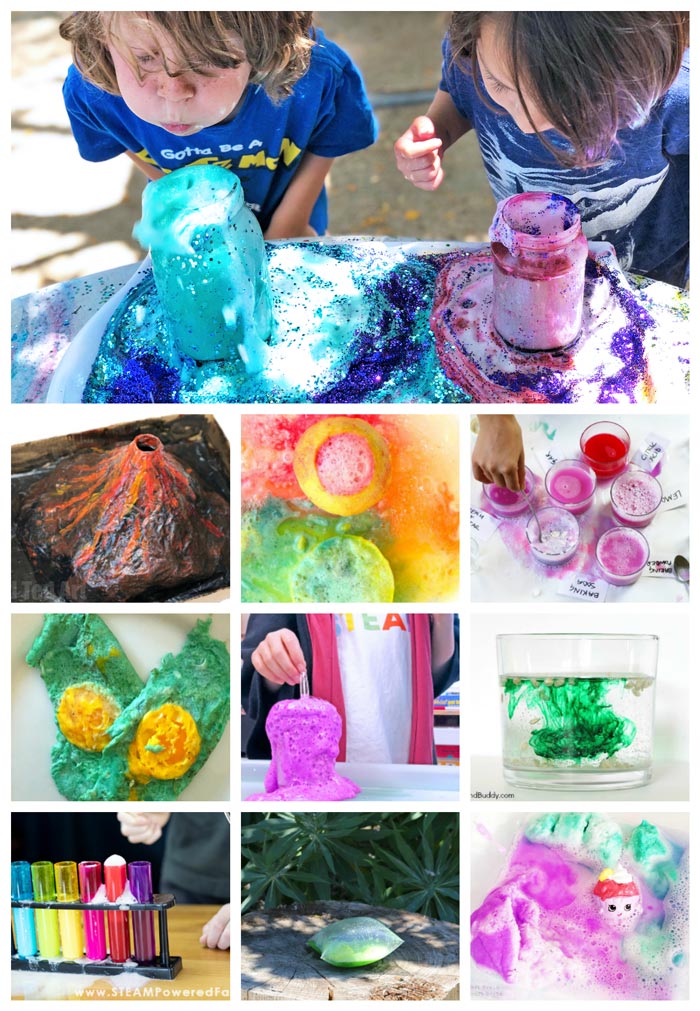
Most liquids are either an acid or a base. Liquids with lots of hydrogen ions in them are considered acids. Liquids with many hydroxide ions are bases. Scientists use a scale called the ph scale to measure how acidic or basic a liquid is. The more hydrogen ions in a liquid the more acidic it is and ranks low on the ph scale. The more hydroxide ions in a liquid the more basic it is and ranks high on the ph scale. You can see what that looks like here.
When acids and bases are mixed chemical reactions occur and the solution becomes neutralized.
Acid and Bases Projects:
1. Baking Soda & Vinegar Volcano
2. Lemon Volcano
3. The Colorful Cabbage Juice Science Experiment and Acid Base Experiment with Cabbage
4. Dancing Rice
5. Green Eggs & Ham
6. Bubbly Citric Acid Brew
7. Baking Soda vs Baking Powder Science Experiment
8. Exploding Bags
9. Rainbow Rubber Eggs
10. Surprise Eggs
11. Rainbow Wizard’s Brew
Chemistry Projects with Fire (Carbon Reactions)
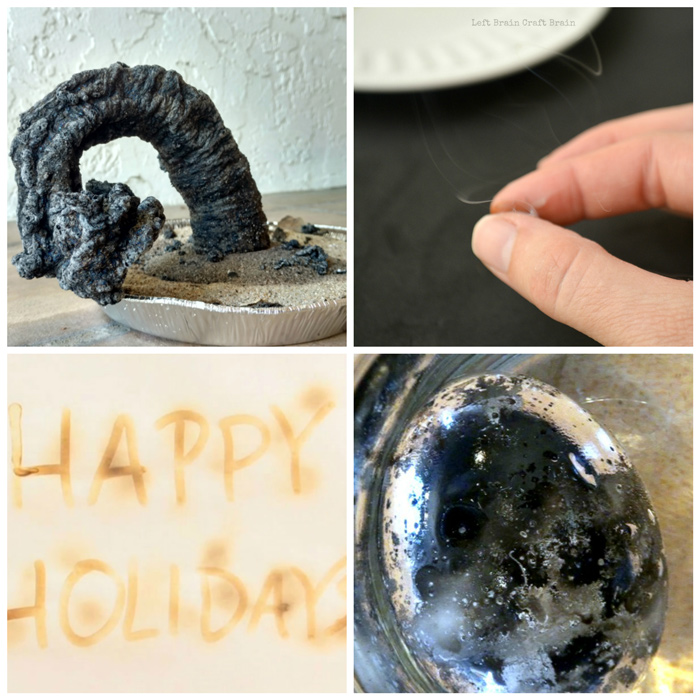
Carbon is the most important element for life. Chemicals that contain carbon are called organic compounds. Carbon has two main forms: The first is in the hard form of diamonds and graphite, and the second is the impure form found in charcoal, coal and soot.
SAFTEY WARNING: Carbon reactions are always fascinating to watch however the presence of fire means that these experiments must be supervised by adults at all times!
Carbon Reactions Projects:
1. Smoking Fingers
2. Fire Snake
3. Silver Egg
4. Invisible Ink
Chromatography
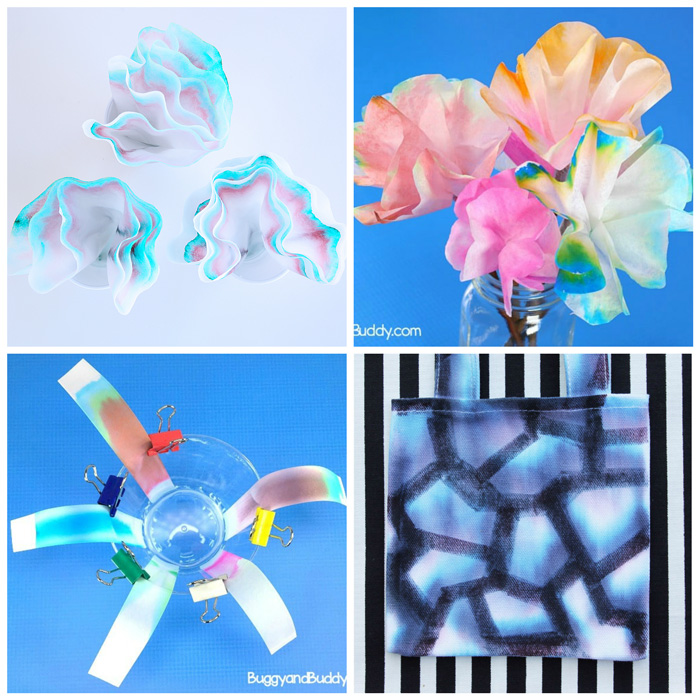
Chromatography is the process of separating mixtures. We usually think of it in terms of color hence the prefix -chroma, however in chemistry is means simply a method of separating mixtures by letting them slowly move past each other. It applies to both liquids and gasses. This is wonderful in-depth explanation of chromatography.
Chromatography Projects:
1. Chromatography
In this project you will separate the color black into other colors. Fold a coffee filter in half. Fold in half two more times until you have a triangular shape. Color the tip of the coffee filter with washable black marker. Get a good coat of ink on the filter. Add a small amount of water to a plastic cup. Place the black tip of the coffee filter in the cup Wait and observe. Come back to the filter after an hour or two and see what happens to the ink. As the coffee filter absorbs water through capillary action, the black ink moves through the filter and is separated by the water into other colors. You should see blue, green and even red as the water separates the ink.
2. Chromatography Flowers
3. Chromatography Art
4. Chromatography Bags
Colloids and Solutions/Solubility

Colloids and Solutions are two types of homogenous mixtures.
- Colloids are mixtures in which a small particles of a substance are suspended throughout another substance but not chemically bonded. They are stable though and do not separate. Examples of colloids are gelatin, butter, mayonnaise, fog and smoke.
- Solutions are mixtures in which the particles of one substance are completely dissolved in another substance. The solute is the substance being dissolved and the solvent is the substance doing the dissolving. An example of a solution is saltwater.
If you want a more in-depth primer on solutions and colloids hop over here.
Colloid Projects:
1. Colloid Examples
2. Oobleck
3. Make Butter
4. Gelatin Streaking
Solutions/Solubility Projects:
5. Ice Sculptures
6. Ice Cream in a Bag
A printable of the science facts at play here
7. Skittles Science
8. Magical Water Blossoms
9. Diffusion Art
10. Paint Solubility
11. Bleeding Blossoms
Polymers
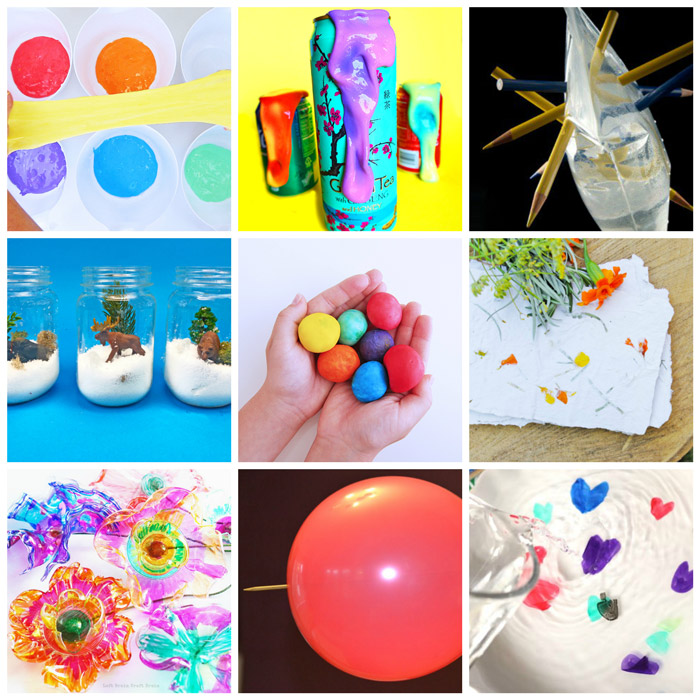
A polymer is a substance made up of a long chain of molecules. Polymers are typically flexible materials like plastic or gum.
The classic polymer kids LOVE to make is slime! Glue is already a polymer but when combined with sodium tetraborate (borax ) the protein molecules of the glue and the borate ions crosslink, making it harder for the molecules to move and forming the gooey, sticky, substance we know as slime.
Other polymers you are probably familiar with are plastic bags, balloons, instant snow, and even the powdery substance found in diapers that expands when wet.
Polymer Projects:
1. Best Basic Slime
Bonus: Get the Science Behind Slime printable here
2. Heat Sensitive Slime
3. DIY Bouncy Balls
4. Magic Plastic Bag Experiment
5. Instant Terrariums
6. How to Make Paper
7. Skewer Through Balloon
8. Dry Erase Figure and Dry Erase Drawings
9. Recycled Plastic Flowers
Crystals
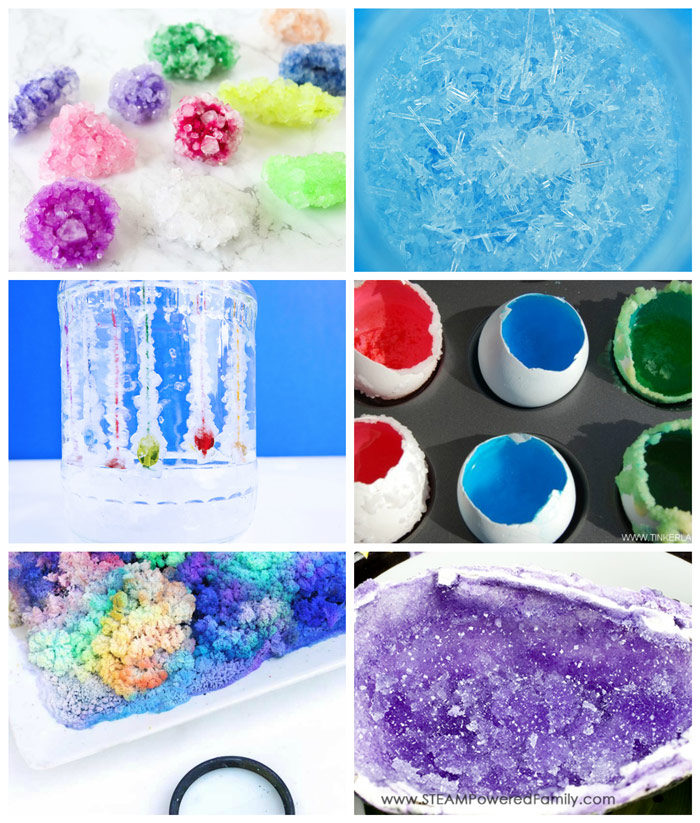
Crystals are a type of material that is formed by patterns of repeating molecules. There are four types of chemical bonds in crystals and therefore four categories of crystals. These are: Covalent, Molecular, Metallic, and Ionic Crystals. You can grow crystals by mixing up a super saturated solution (usually with a type of salt and water) and letting it settle over time so crystals will form. Check out the various types of easy to grow crystal below and go here to read more about the science of crystals.
Crystals Projects:
1. Classic Borax Crystals
2. Overnight Crystal Garden
3. Egg Geodes
4. Crystal Wind Catchers
5. Crystal Landscapes
6. Candy Geodes
7. Salt Crystals
Conclusion & More
Alright you guys, do you feel like you have some good project ideas for exploring chemistry with kids? Many of these will make greats science fair projects. Be sure to start with them as a topic then start asking questions, form a hypotheses, and do some experiments.
Now I have to admit that I really fell in love with chemistry projects as an adult. Working with kids in camp, after school, and with my own kids at home I’ve had the chance to try fun chemistry projects and discovered that I love watching chemical reactions AND the reactions on the faces of kids and bystanders during demonstration or project!
If you have kids who fall in love with this branch of science please do check out the incredible book series Elements, Molecules, and Reactions by Theodore Gray (see the series in our Amazon science ideas list here) The books are stunning, informative, easy to understand and, wait for it…funny!
Another valuable resource for kids who love chemistry is Mel Science’s Chemistry subscription box. They send you a starter kit for free with all the materials you’ll need and then each month you get a new chemistry experiment delivered to your door! This is great product because a lot of specialty chemistry ingredients are hard to find and these kits simplify getting the materials you need! Check it out here:
Are you passionate about raising creative kids?
Join over 22,179 parents and educators who want connect with kids and nurture their creative process through magical, easy projects you can do TOGETHER.
Subscribe to our email list to receive project ideas as well as offers for some our creative products.
If you want to read our privacy policy before subscribing, hop over here.
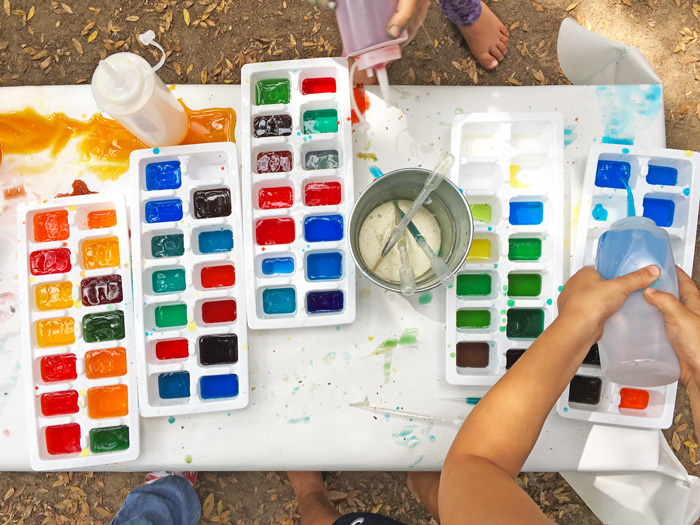
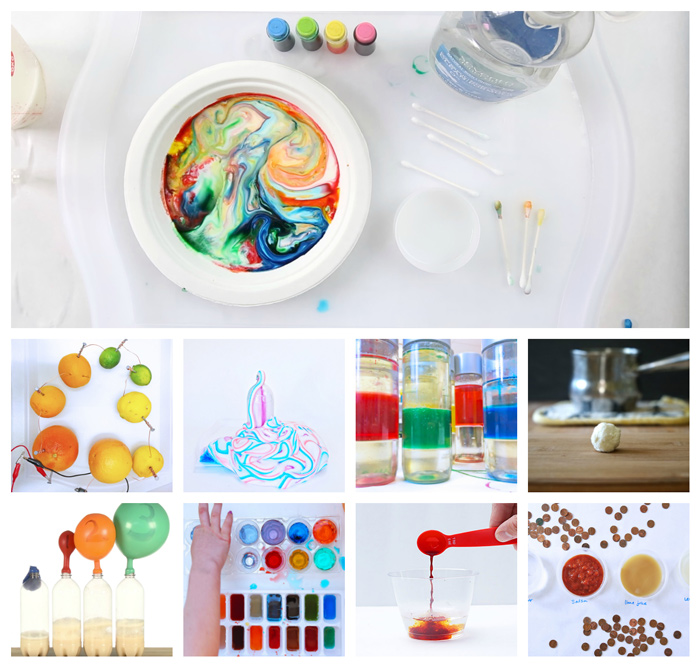 What is a chemical reaction?
What is a chemical reaction? 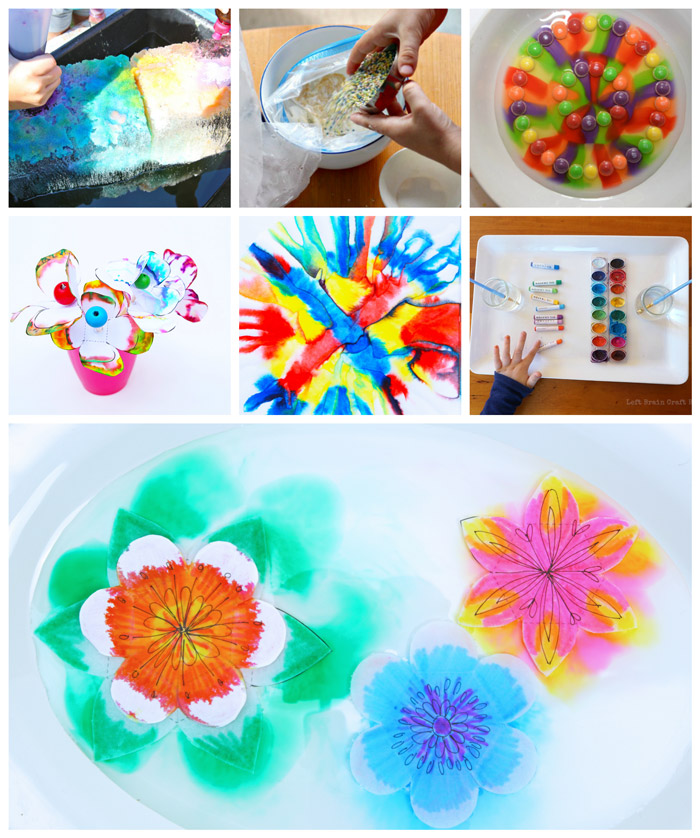

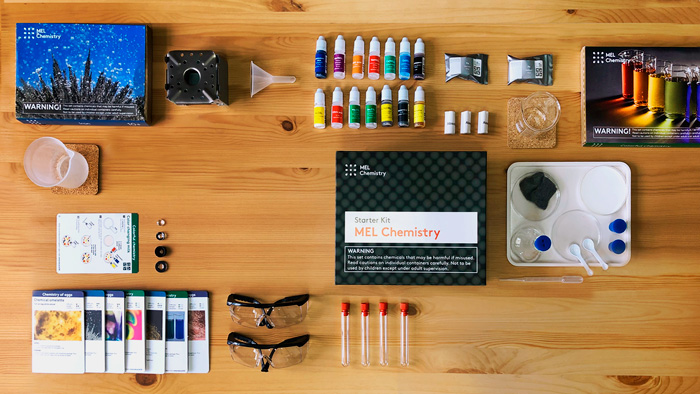
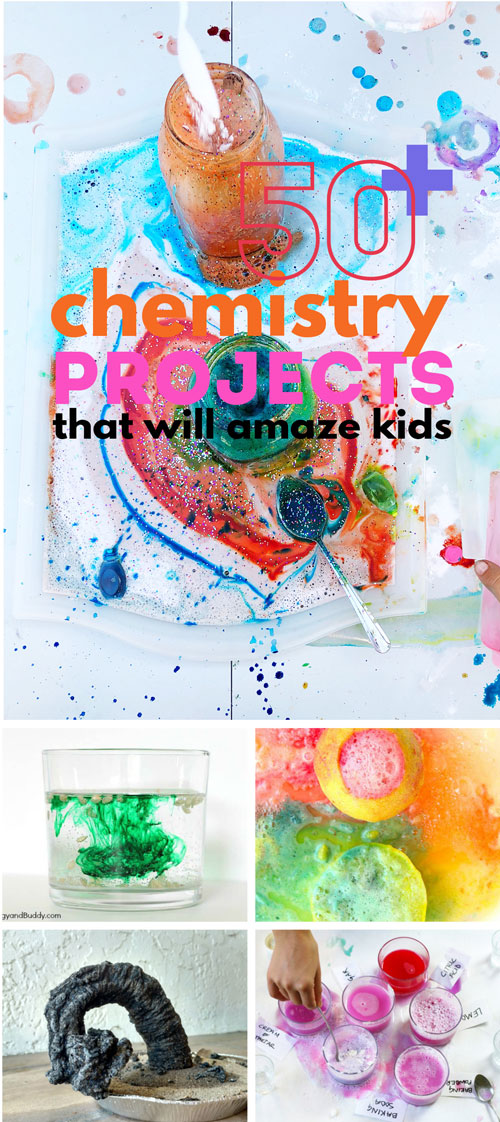
These were some really awesome projects. I really liked the Citrus Battery projects. It seems simple and easy for a young kid. I wish schools should give more focus to such experiments instead of shoving down the theoretical knowledge down the throat of young kids.
Is all of this info available on book form?
Not at this time but that’s a great idea!
Thank you for making this fantastic collection of experiments with clear directions and easy to understand explanations of the science behind the fun! I know I’ll refer to this list often. I especially appreciate the way the experiments are classified/organized. I teach art with science connections and we are already planning on chalkboard and magnetic slime :). I’ll be sure to tag Babble Dabble Do when I post photos of work inspired by this on target collection!
These are all great ideas! I’m pretty sure the kids will have fun and love this activities